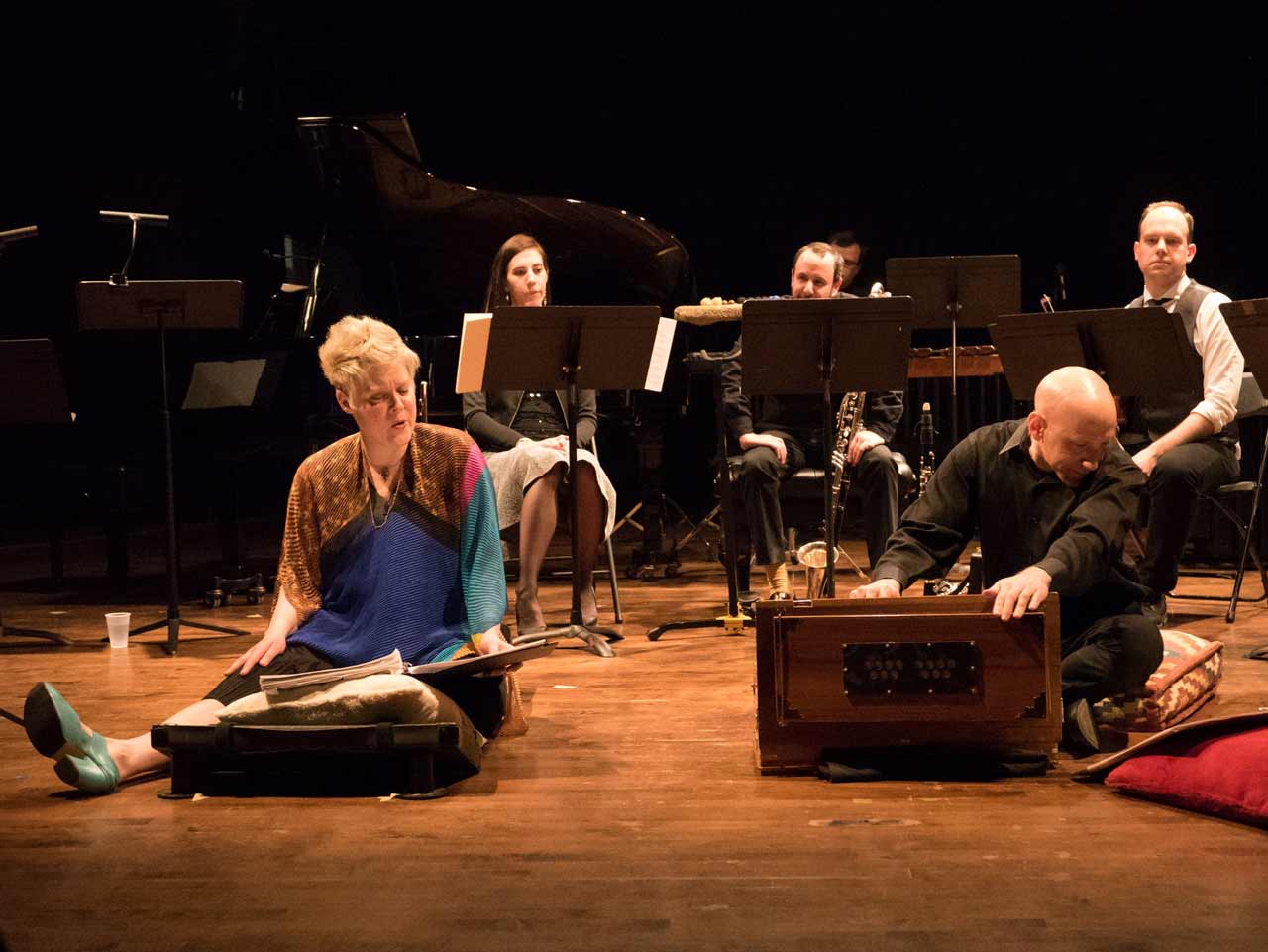Works
“Williams’s work is witty and light on its feet, curious and playful… a serious fun that’s all her own.”
—The New York Times
Photo by Rob Davidson
Solos and duos
For the Bugallo-Williams Piano Duo
The Bugallo-Williams Piano Duo performs Abstracted Art I
The process for composing Abstracted Art I and II for piano duet involved the abstraction of particular articulations, harmonies, figurations, and modes of playing taken from recordings of the great jazz pianist, Art Tatum. These pianistic gestures were simplified into purely verbal descriptions, which then became the starting point for composing—an attempt to capture something of the sound of Art Tatum without any actual borrowing of musical materials.
For Amy Briggs
Jeffrey Jacob performs Astoria
Astoria uses a transcription of Astor Piazzolla’s tango, Movimiento Continuo, as a point of departure. The block-like, sectional structure is taken, with each section gradually condensed. Some of Piazzolla’s harmonic progressions, repeated rhythmic patterns, ornamental gestures, and melodic fragments are re-organized, transformed and combined with original material.
Commissioned by Calvary Episcopal Church (Pittsburgh)
Solo organ version performed live by Ere Lievonen
Brigid’s Flame was written in memory of my father-in-law, Robert W. Slammon, who died in 2004. In writing the piece, I became intrigued with Saint Brigid. She was named after the pagan goddess of fire, whose manifestations were song and poetry (“the flame of knowledge”). Saint Brigid is associated with many symbols, including sacred flames (eternal fire, candles, the hearth), high intelligence, poetic eloquence, the number 3, and childbirth. In the 5th century, Saint Brigid founded a convent in Clara, County Offaly (Ireland), where my father-in-law’s ancestors were from. Bob was also a fireman. All of these diverse influences came together in this piece, which flickers eternally.
For the Bent Frequency Duo Project (Jan Berry Baker and Stuart Gerber)

Live performance with Bent Frequency
Inspiration sometimes comes from the farthest reaches and sometimes from very close to home. In this case, I chose very small objects from my children’s toy boxes—those that I found to have a sufficient range of sonic possibilities. In the first piece, the whistles blend with the saxophone to create a fused, enhanced sound; in the second, a true duet; and the third, two contrasting, but complementary sounds.
“Williams’ writing is as ever inventive and enjoyable from start to finish.”
—NACWPI Review
Commissioned by the CUBE Ensemble
Performed live by Due East
Cineshape I is the first in a series of pieces for various instrumental groups that are inspired by films. In this case, the film is “Chunhyang,” the epic Korean tale of a virtuous woman who is sentenced to death for spurning the Governor’s advances while waiting for her husband to return from his lengthy studies. The film is narrated by a singer and lone drummer using the ancient Korean operatic tradition of pansori—a stylized art form incorporating storytelling, dance and music. There are no direct references or quotations of this powerful traditional music, however, and the film plot is never incorporated programmatically into the piece. The inspiration is more abstract and structural: percussive emphasis of the lyrical/vocal flute line, moments of pentatonicism, a gradual increase in intensity, breathlessness.
Commissioned by Lincoln Center for pianist Jacob Greenberg
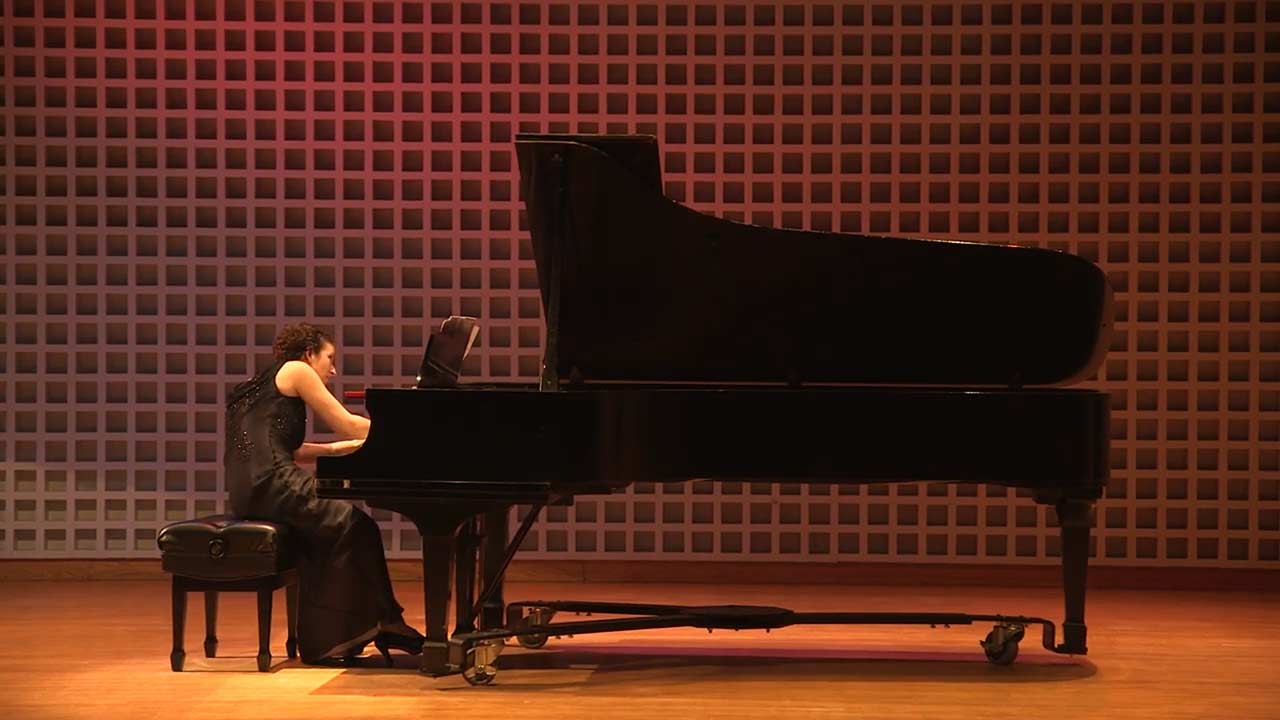
Performed live by Clare Longendyke
Cineshape 4 for solo piano takes structural elements from the German film “Run Lola Run” as a point of departure. This film is divided into three episodes; Lola repeats the same day three times, starting in exactly the same way, but each time hoping that a slight modification of her actions will save the life of her boyfriend. This simple concept—that minor choices impact the unfolding of events—leads to a multifaceted structure. Much like the film, the piece is high-paced and energetic, literally running from start to finish with only occasional moments to stop and take a breath.
Commissioned by the Pittsburgh Chamber Music Society to celebrate the 250th birthday of the city of Pittsburgh
Crossings for piano duet uses the 250th chorale by J.S. Bach—“Ein’ feste Burg ist unser Gott”—as a bare framework onto which original harmonies are inserted and superimposed. The chorale appears numerous times at gradually accelerating speeds and in different registers, transpositions and voicings—though always well-hidden beneath the accumulating texture. The word “crossing” has multiple meanings that are appropriate to the piece: the action of moving across or over something (in this case, the crossing of the two pianists’ arms), an intersection, a journey, a mixture or compromise of two things. The topography of Pittsburgh was also influential in determining the shape of the piece.
Don’t Tell Susan was written for the unforgettable Robert Black for a solo bass recital he played at the Albright-Knox Art Gallery in Buffalo. An exhibit of paintings by Susan Rothenberg was being featured at the Gallery at the time. Horses are one of the main subjects of her dynamic and expressive works. There are a few somewhat silly puns and references to horses and horse-riding in the music, which I thought best not to reveal to the painter. Thus the title.
Duo for alto saxophone and piano is in three movements—converge, merge, diverge—each of which illustrates a unique form and instrumental relationship. The first movement has a complex, predetermined structure, in which highly diversified materials are juxtaposed, each phrase becoming shorter and more related to what follows. The second movement presents a more complementary and traditional relationship between the piano and saxophone. The third movement begins with the two instruments closely intertwined and gradually pulling apart into independent roles.
First Lines was composed while I was in residence at the Bellagio Center on Lake Como in Italy. The piece was inspired by Bellagio—the place and its residents—in a very direct way. As I was perusing the library, I noticed numerous titles of books of poems that were suggestive of music and time. I began reading these books and I was struck by the ability of a strong poem to instantly pull the reader in, to create a richly developed atmosphere in the very first line. I began to imagine how this same effect could be achieved with music. That set me on the course of writing a series of miniatures—each piece inspired by a different poem and lasting as short as 15 seconds and as long as 3 minutes. The poems I was most intrigued by were written by women, all former residents of Bellagio.
“Williams shows her gift for instant characterization, always tested by writing miniatures, as well as purposeful use of non-traditional tone production in “First Lines.” At the end of the piece about not waking a grandmother, we’re left with the sound of grandma’s steady, sleeping breathing — through the flute…. The final miniature, about the surprising stillness of water, also was the most beautiful. Built of simple musical ideas, it includes a harmonic tease at the end, leaving us wondering about where the rest of the poem goes and what the composer’s response to it might have been.”
—Pittsburgh Tribune
For Austin Wulliman on his 40th birthday.
For Jacob Greenberg and Tony Arnold
Each miniature is inspired by a single German word:
- Frühjahrsmüdigkeit (n) A sense of listlessness brought on by the coming of spring.
- Fingerspitzengefühl (n) Literally “fingertip-feeling”. Intuitive empathy with things and people.
- Verschlimmbessern (v) To make something worse in the very act of trying to improve it.
- Kuddelmuddel (n) An unstructured mess.
- Sehnsucht (n) An intense yearning for something far-off and indefinable

Performed by Jay Campbell and Amy Williams
Give Way is a companion piece to Stop/Yield—more continuous in structure and fully determinate, focusing on blended sonorities that diverge and coalesce.
For the Bugallo-Williams Piano Duo
This short work is an arrangement of my solo piano piece, Lukas. There is a clear reference to Bach and to Foss’s perpetual motion Solo for piano.
For the Bugallo-Williams Piano Duo
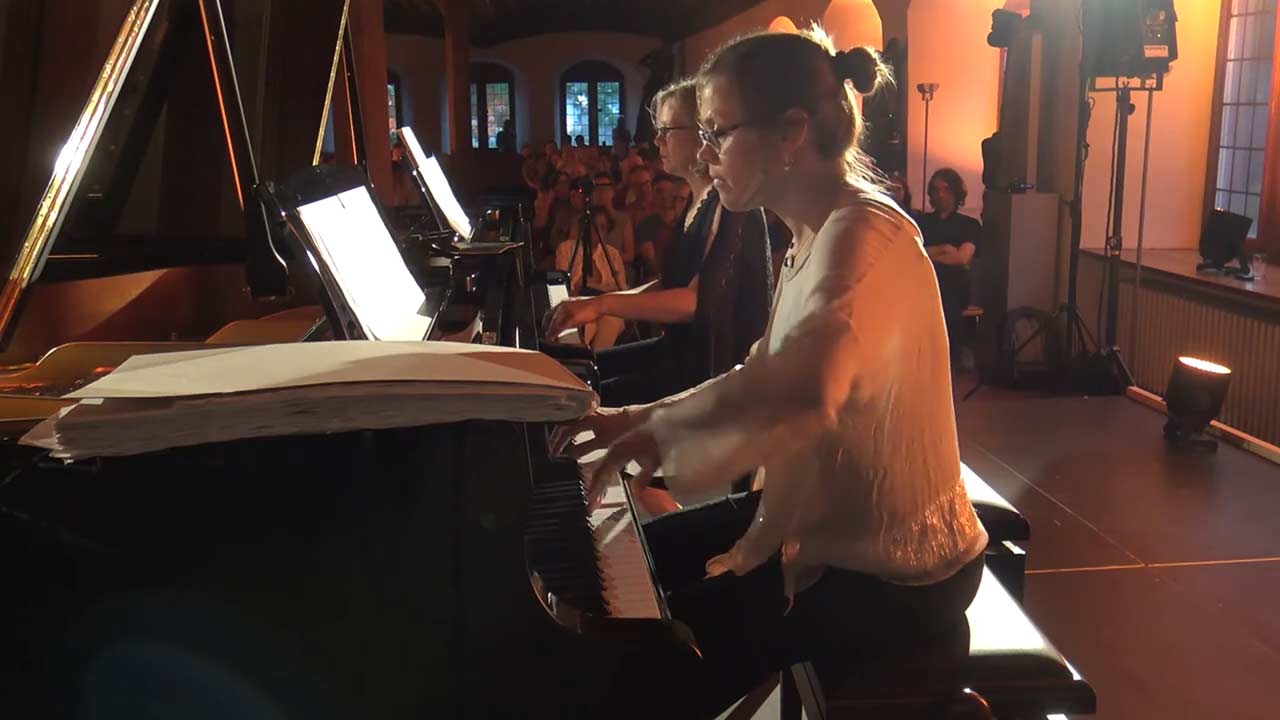
Performed live by the Bugallo-Williams Piano Duo
On and On is an expansion of my solo piano piece, Yvar—a portrait of my mentor and friend, Yvar Mikhashoff. The two pianos bring in new materials, particularly a reference to The Alcotts by Charles Ives, one of Yvar’s favorite pieces. It was written for Felix Meyer on the occasion of his retirement as the director of the Paul Sacher Stiftung.
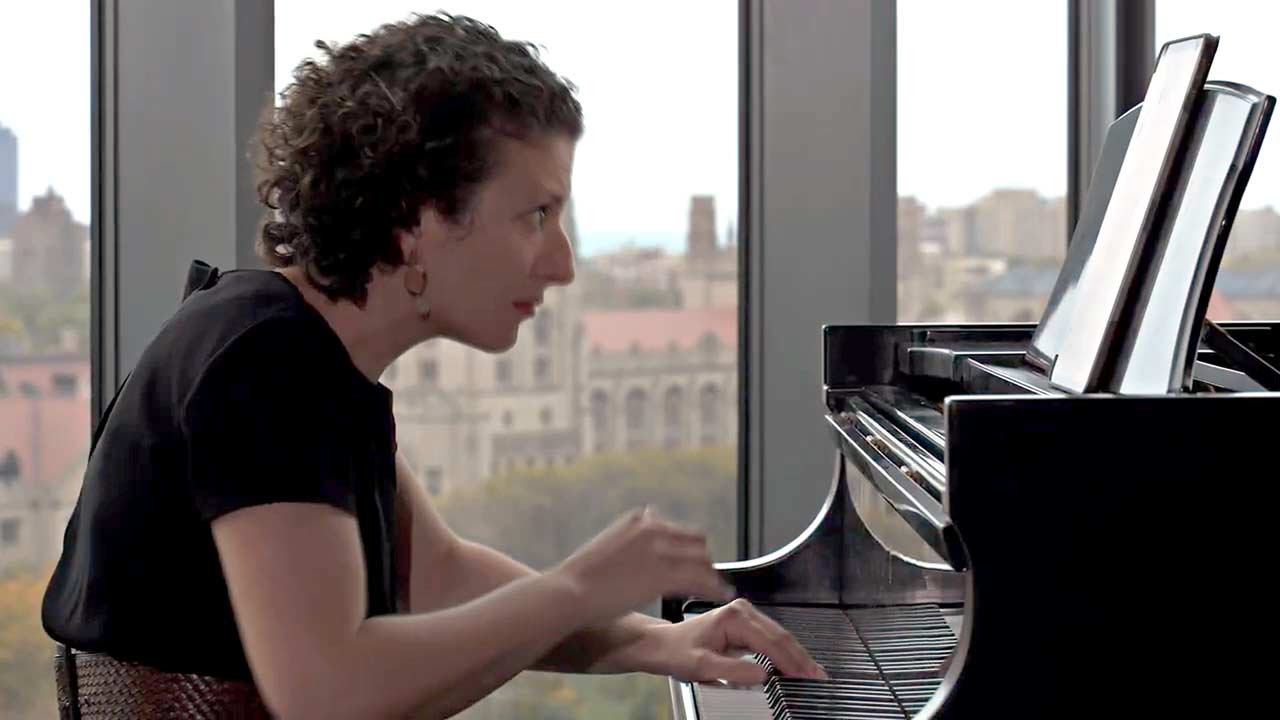
Book II performed by Clare Longendyke
Hibbard, Frieda and Olga performed by Joe Howson
Piano Portraits is a collection of short pieces that could be subtitled “The Pianists in my Life.” Each piece references one of ten incredible pianists I have been lucky to directly interact with—from my earliest memories of playing the piano with my grandmother (Olga) and listening to jazz with my grandfather (Hibbard), to formative concert experiences of hearing the piano duo version of The Rite of Spring and Morton Feldman’s trios, to collaborators I have been fortunate to play with or have interpret my works. The Portraits contains memories of brilliant pianists who were inspiring to me as teachers (Yvar Mikhashoff, Nils Vigeland, Frieda Manes, Allen Shawn and Elizabeth Wright) and colleagues (Ursula Oppens and Helena Bugallo) and as a model of what kind of musician I hoped to be (Lukas Foss). Losing a friend can focus these memories. Argentine composer and conductor Erik Oña—a dear friend and colleague since 1993, one of the most original and inspiring musicians I will ever know—died in September 2019 after a short battle with cancer. I was thinking of him throughout the writing of this piece. Piano Portraits was commissioned by the phenomenal pianists Elliot Wuu (Book 1) and Clare Longendyke (Book 2).
“Williams’s iridescent “Olga”…presents a luminous homage marked by vitality, curiosity and wonder.”
—Textura
Stop/Yield was written as a 60th birthday gift for fellow composer and dear friend, Amnon Wolman. Amnon’s experimental approach—his willingness to take chances and challenge the status quo—was always on my mind when writing this short piece for cello and piano. I attempted to shed some of my controlling ways, allowing for more flexible performer interaction and involvement. Improvisational materials are juxtaposed with those that are strictly composed.
Commissioned by the Stony Brook Contemporary Chamber Players
Study in Syntax is the first in a planned series of works inspired by the unique linguistic structures of different writers. Each piece will explore such commonalities between music and language as rhythm, repetition, cadence, rhyme, and phrasing. For this work for viola and piano, I studied the 1957 radio play, Embers, the text of which Beckett himself described as “rather ragged.” The play is an internal monologue—a “soulscape”—with the other minor characters likely being only memories in Henry’s mind. What particularly intrigued me was Beckett’s consistent use of repetition (of words, phrases and phonemes): short phrases with the words in a slightly different order, monosyllabic words, the return of significant words immediately or circularly after much time and always re-contextualized.
Commissioned by the Sinquefeld Charitable Foundation for the New Muse Piano Duo
The term “switch” has multiple meanings that are relevant to this piece for piano duet: a device for making and breaking the connection in an electric circuit; a sudden change; a shift in direction or focus; a thin, flexible rod or twig; to exchange or swap; to jerk or swish abruptly. It can also be onomatopoetic. The pairing of two players at one piano is central to the construction of the piece. One shadows the other, or interrupts with dissimilar music, or coexists with a contrasting but complementary texture, or cooperates in search of common ground (which is only reached at the end of the piece). The inside and the outside of the piano interconnect, as do normal and prepared notes. The physical position of the players is also flexible, as there is no “normal” register for the top and bottom parts. All this illustrates some of the challenges and certainly the joy of playing four-hands.
For Duo Diorama
Wrest was written in memory of my dear friend and colleague, M. William Karlins. The piano begins as a faint echo, almost entirely concealed by the violin’s shouting and stammering. The piano begins to assert itself independently. Eventually they work together to create an escalating composite texture. Over the course of the piece, a twelve-tone row materializes, ending with a cyclical repetition of the series, like a music box that winds down and then just stops.
Chamber
Co-commissioned by the Denver Friends of Chamber Music, the Celebrity Series of Boston and the Philharmonic Society of Orange County for the Junction Trio
The term “bells and whistles” comes from the fairground organ and also from early 20th century “master” clocks, which could operate different clocks throughout a factory or school to ring bells or blow whistles. These sonic images are combined with other types of bells (fire alarms, train whistles, bell towers, cuckoo clocks, anvils). The piece is in three continuous sections—the first is focused on clocks (mechanical, ticking sounds), the second (fast, driving) trains, and the third (ringing, accumulating) bells.

Performed live by Shai Wosner and the JACK Quartet
Cineshape 2 is the second in a series of five pieces inspired by films. This work is based on Mike Figgis’ “Time Code,” in which the screen is split into four equal parts and actions occur in real time. The viewer follows various linked characters at an independent film production company in Los Angeles. In the piece, there are highly diversified materials in the string instruments: aggressive multiple stops in the viola; a texture evocative of Renaissance music played by the muted viola and cello; a syncopated, choppy line divided among the two violins; impulsive and expressive cello solos; static, repeated chords that immediately die away. In the film, it is the soundtrack (one that is equal parts music and spoken dialogue) that binds the conflicting perspectives of the four screens together. In the piece, it is the piano, which mimics the actual grid of the film. These diverse materials represent characters, though not in a literally narrative way. As in the film, these musical characters that, at first, seem to have nothing in common, gradually transform into related musical ideas.Certain of these ideas come to the foreground, while others fade to the background. They are continually transformed, varied, moving forward—after all, in real time, one can never repeat oneself exactly.
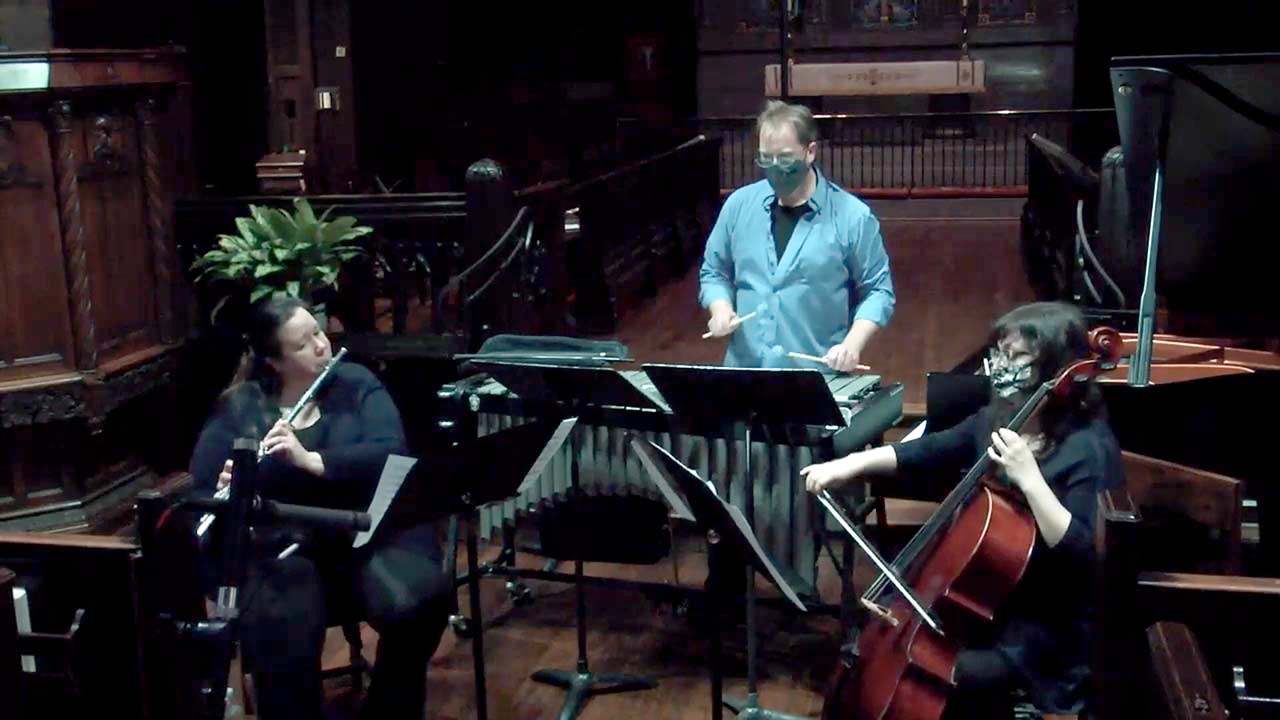
Performed live by New Ear
Cineshape 3 is the third in this series of pieces inspired by films. The film, in this case, is “The Lives of Others” by German filmmaker Florian Kenckel von Donnersmarck from 2006. Perhaps more programmatic than other pieces in the series, the translation of the three main characters of the film into three instruments is clear. The piece is concerned, just as the film is, with the manipulation and transformation of established identities. The soloistic cello at the beginning is subtly enhanced by the percussion and flute. The flute becomes more interfering, affecting the cello’s thematic materials. The percussion, despite attempts at independence, always conforms to and supports the other two, but is eventually expelled.
Performed by Lindsey Goodman (flute), Scott Christian (piano), Amy Williams (piano) and the JACK Quartet
Cineshape 5 is the last in a series of pieces for varying chamber groups, each inspired by a different film. The inspiration, in this case, is Alfred Hitchcock’s masterpiece, “Rope.” In this film, which begins with a murder and ends with its detection, Hitchcock experiments with a strictly linear and unified structure of time (actions occur in real time) and place (one location). He filmed in what appears to be one long, unbroken shot, with a few, nearly undetectable cuts. The story is focused around a wooden chest in the center of the room, where the victim’s body is hidden. Likewise, musically, there is a single musical object (a central melodic line) that the entire piece revolves around—first a flute solo, then a violin duet, and finally a piano and cello duet.
Performed by Lindsey Goodman (flute), Scott Christian (piano), Amy Williams (piano) and the JACK Quartet
#1: piano | 1′
#2: violin/percussion | 1′
#3: alto flute/violin/viola | 1′
#4: string quartet | 1′
For Talujon
Performed live by the Fredonia Percussion Ensemble
Dream Landscape was written to commemorate the 100th anniversary of John Cage’s birth. The title fuses Dream and In a Landscape, two early Cage piano pieces. The focus in his pieces is on simple, repetitive melodic materials, which create an undulating and peaceful atmosphere. My piece, with vibraphones, glockenspiels and triangles, intends to create a similarly flowing environment.
For Talujon
Performed live by the Fredonia Percussion Ensemble
Dream Landscape was written to commemorate the 100th anniversary of John Cage’s birth. The title fuses Dream and In a Landscape, two early Cage piano pieces. The focus in his pieces is on simple, repetitive melodic materials, which create an undulating and peaceful atmosphere. My piece, with vibraphones, glockenspiels and triangles, intends to create a similarly flowing environment.
JB Clips is a quintet version of my brass ensemble work, JB Montage. In the larger piece, there is a quintet in the center that is backed up by a larger group surrounding it. The basic material for both is riffs and grooves taken from the rhythm section of various James Brown funk tunes.
Performed live by the Pittsburgh New Music Ensemble
Ligamy was written for the Pittsburgh New Music Ensemble for a program revolving, quite literally, around György Ligeti’s early multi-movement solo piano piece, Musica Ricercata. In this case, movements 6 and 7 are bridged by this short work.
Commissioned by the Pennsylvania Music Teachers Association
Performed live at the 2023 PMTA Conference
Over, Above is an expansion of my two-piano piece, On and On, which is an expansion of my solo piano piece, Yvar.
Commissioned by the Chamber Music Conference
Latin for “whatever you wish,” Michael Praetorius provided the first systematic definition of quodlibet in 1618 as “a mixture of diverse elements quoted from sacred and secular compositions.” In my new chamber work, borrowed melodies by Domenico Scarlatti (1685-1757) and John Cage (1912-1992) are interwoven both successively and simultaneously. In the process of learning John Cage’s masterful Sonatas and Interludes, I became entranced by his gorgeous melodies, which are obscured and transformed for listeners by the preparation of the piano with screws, nuts, bolts, pieces of rubber and plastic. The keyboard Sonatas of Domenico Scarlatti provided the framework for the clear-cut binary forms that Cage modeled in his Sonatas. My source materials, particularly Scarlatti Sonata #27 (presented in the first section of my piece) and Cage’s Sonatas #14/15, are both clearly present and continually recontextualized through adding various kinds of distortion (timbral, textural, countermelodies, punctuation) and removing the timbral modifications of the piano preparations.
Commissioned by the Fromm Music Foundation of Harvard University for the JACK Quartet

Performed by the JACK Quartet
Each of the seven short movements of Richter Textures was inspired by a different painting by German artist Gerhard Richter (b. 1932). The selected paintings—some landscapes and some abstract—all have complex and strikingly beautiful textures. In his abstract works, Richter gradually builds up many layers of non-representational painting. Likewise, each movement of the music has one texture (sometimes alternating with a contrasting texture) that comprises the main sound material; however the subtle details of motivic, rhythmic and timbral variation add a layer of complexity. The seven movements, each possessing a distinct sound world, are to be performed without pause.
““…the evening’s most thrilling revelation was the work of composer Amy Williams, whose ‘Richter Textures’ is an attempt to capture in sound the look and feel of seven paintings by the German artist Gerhard Richter…Williams’ 20-minute string quartet — a series of seven superbly delineated movements played without pause — bristles with such imagination and vitality that the music soars free of its original inspiration. The textures of the title are vivid enough in themselves — jittery, beautifully turned bursts of figuration in the first movement, a sequence of eerie, static string harmonies in a later one, a densely packed chord that exploded in chugging rhythms to close. But on top of that, Williams’ harmonic choices are always both refined and surprising, and her mastery of rhetoric compelling at every turn. The JACK Quartet gave the piece a beautiful, robust and alert performance. In a just world, ‘Richter Textures’ would find its way into the repertoire of every comparable ensemble.”
—San Francisco Chronicle
Performed live by the Empyrean Ensemble
Sextet moves between two sound worlds: one marked by chaos and fierce independence and the other by an abandonment of individual identity. The opening has four solos presented simultaneously, with each instrument striving to be in the spotlight. Whenever there is a moment of peaceful collaboration, the piano instigates another divisive statement of uncoordinated solos. As the piece progresses, the distinction between these two contrasting materials becomes less defined, until all instruments are working together. There is no agreement between the players about how to end the piece: a strongly conclusive unison gesture in the flute, clarinet and piano makes one emphatic closing; the strings have a sustained fade out (after one more soloistic outburst from the violin); and the at first assertive chimes solo gradually sputters out.
“…daring in its premise and refreshing in its textural immediacy.”
—San Francisco Classical Voice
Commissioned by Miller Theatre of Columbia University for the JACK Quartet
Performed live by the JACK Quartet
The title is taken from the last line of a Robert Morgan poem entitled “History’s Madrigal.” This poem references “fiddle makers” and their need to use “antique” wood to make “truer and deeper music.” The poem ends with the line: “…the memory and wisdom of wood delighting air as century speaks to century and history dissolves history across the long and tangled madrigal of time.” My string quartet interfaces quite continuously and in varied ways with a historical artifact: Nicola Vicentino’s 16th century madrigal “Musica prisca Caput”. This short vocal piece is a radically forward-thinking study in tuning systems—diatonic, chromatic and enharmonic (microtonal). The piece utilizes these three tuning systems. Its also occasionally and in limited ways references the prelude from the first Bach cello suite.
“Williams never directly quotes her Vicentino source, but combining the elegant formality of antique styles with a contemporary sound world, she maintains her characteristic, tricky balance between sobriety and mischievousness — a serious fun that’s all her own.”
–The New York Times
Commissioned by Instruments of Happiness
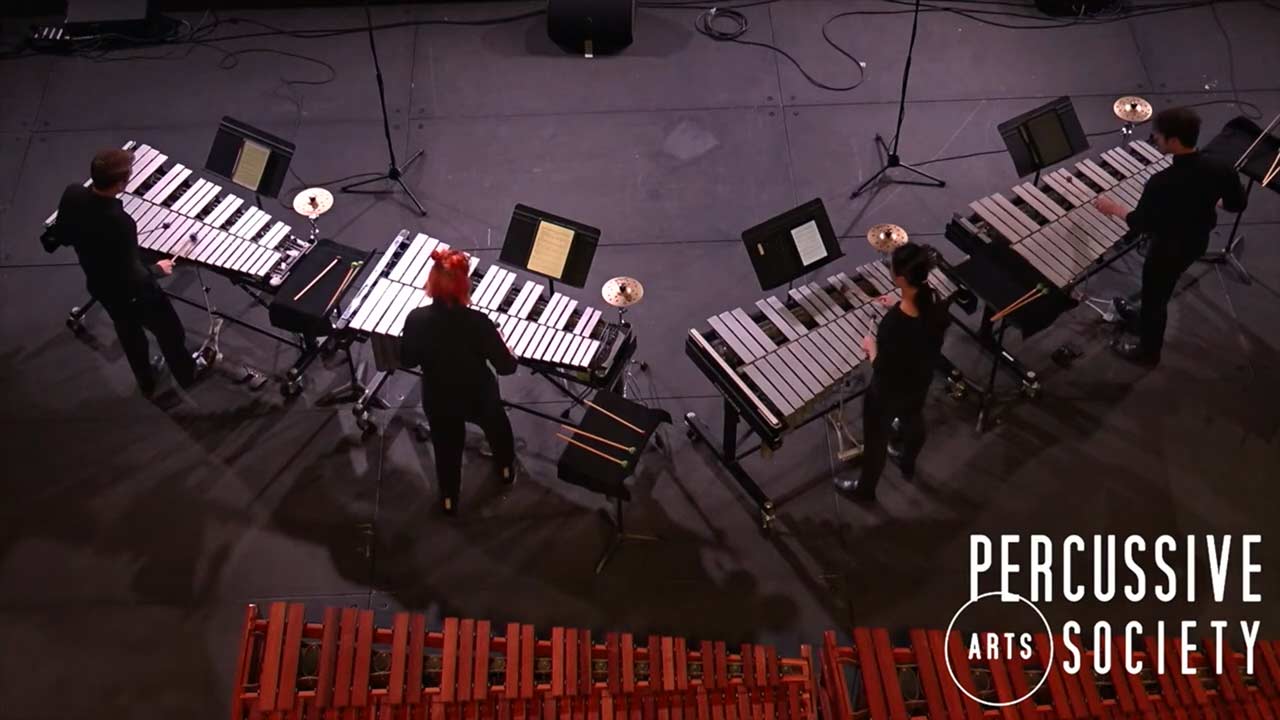
Version for four vibraphones performed by the UNCG Percussion Ensemble
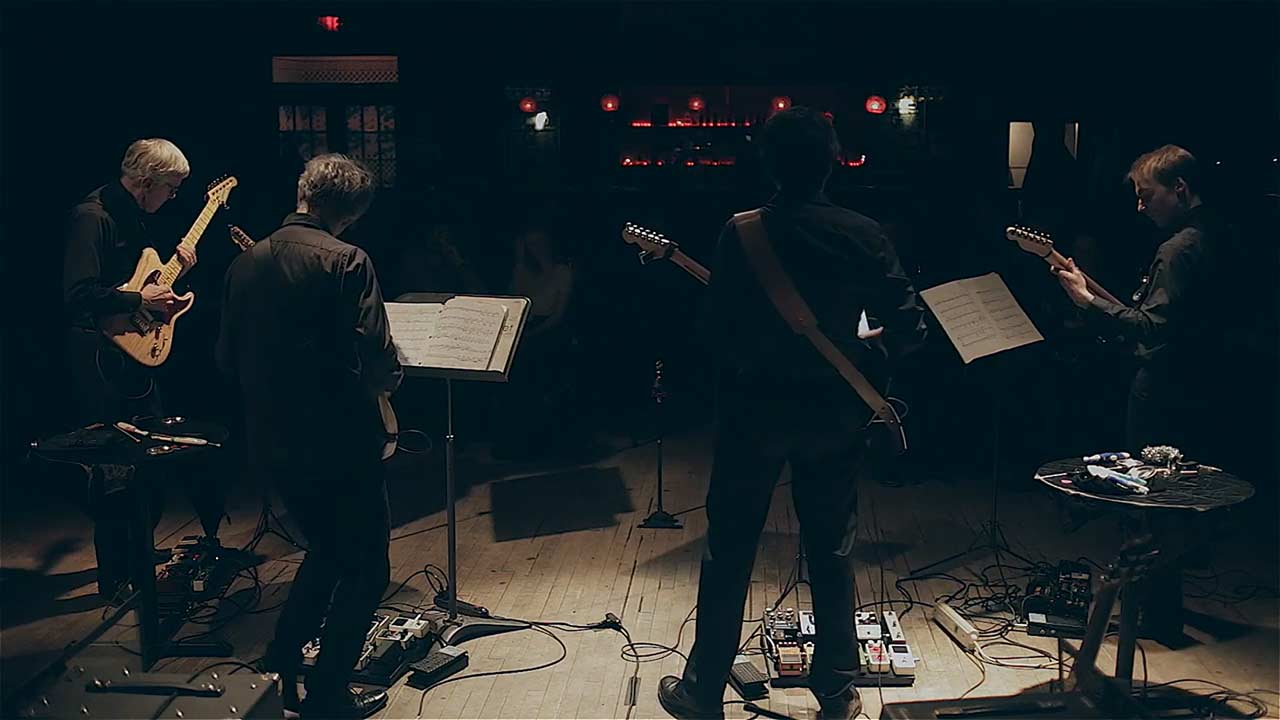
Version for four guitars performed by Instruments of Happiness
Unison… is for four identical, wide-ranging instruments that are capable of playing a large variety of timbral modifications to distort the often unison textures in the piece. These distortions are organized into categories (noise, attack, bend, mute, etc.) but the performers ultimately decide how they want to interpret these indeterminacies. Each group also decides their own title, beginning with the word ‘unison’, that is appropriate for their interpretation. The work was written for Tim Brady and the Instruments of Happiness, with gratitude for bringing me into the terrifying and exhilarating world of the electric guitar.
For the H2 Quartet
Univocity is a philosophical term that means “one voice.” I was particularly interested in Gilles Deleuze’s use of it as a way of describing Being and that difference connects us all. It seems appropriate for the saxophones, with subtle differences in the instruments, but which are all one family (voice). The piece undergoes an always-differentiating process, from a single voice to maximum difference and back again.
Commissioned by the Serge Koussevitsky Music Foundation for Tony Arnold and the JACK Quartet

Performed live by Tony Arnold and the JACK Quartet (movement 4)
Urquintett is inspired by Kurt Schwitters’ pioneering work of sound poetry, the Ursonate, completed in 1932. The source material is transformed in continuously varying ways, including the strings “playing” the text and the singer deconstructing the text into even smaller sonic fragments. Although the quintet is also in four movements, it does not conform to the sonata form. There is not one definitive performance version of the Ursonate—in fact, the variety of the presentations that it can take speaks to its strength as a true masterpiece. I hope that my Urquintett is both a tribute to the work and a piece that demonstrates that these specific words(=sounds) can be fertile ground for new art.
“Williams’ Urquintett, for soprano and string quartet follows from Kurt Schwitters’ Ursonate…In one way, Williams’ work is analogous. Instead of notes and rhythms, she breaks down her musical language to simple, small sounds and gestures, like attacks and articulations, and builds it up from there….The attractive sound and fun of the music came through in the performance.”
—New York Classical Review
